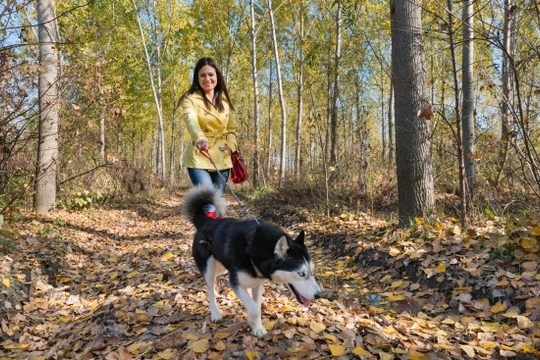Pets
Pets for studWanted petsBreedersAccessories & services
Knowledge hub
Support
Support & safety portal
Staying safe when walking your dog
A ten minute trip around the block with your dog in the same way that you do every day may well lull you into a false sense of security and routine about your dog walks, but do you actively pay any mind to your safety when you are out with your dog? All dog owners generally spend a considerable amount of time and effort ensuring that their dogs are safe, don’t get into a pickle and keep clear of the road, but it is all too common for the dog owner to overlook their own safety!
If you might be guilty of doing this, read on for our tips and advice on staying safe while out walking with your dog.
What you wear
It is easy to overlook appropriate clothing for dog walking if you are only going for a short walk or around the roads, but just take a couple of minutes to review what you are wearing. You don’t need to be dressed for running around if you are just going for a stroll with your dog, but at a minimum, ensure that you are wearing sensible shoes, a suitable coat, and something reflective or lit if you will be out after dusk.
Where you go
Don’t venture out into unknown areas without taking the time to get the lay of the land first, by visiting in your car or asking around other dog walkers or locals. Take the time to find out about any restrictions on dog walking, if private land is off limits, and if there are any hazards to be aware of or places to avoid.
Is anyone expecting you?
While it would be highly impractical for most dog owners to make someone aware of where they are going and when they will be back every single time they pop out with the dog, it is always good to have someone who will notice if you don’t come back! Make sure that a friend or family member knows what times you are likely to be out walking at, and the routes that you may take, and that they are savvy enough to notice if they don’t hear from you for a bit or have problems getting in touch with you. If you are going somewhere new of doing something different, let someone know.
What would you do if you got into difficulties?
It is wise to have a plan in place for how you would deal with the issue if something went wrong. If you sprained an ankle when out and about or if your dog got injured, who could you call for help? Would you even have your phone with you, and can you get a signal? If you got mugged or lost your phone, how could you alert someone to the fact that something has happened to you? It is wise to run through a few worst case scenarios and problem-solve them theoretically, so that you have some ideas to fall back on in the unlikely event that something bad does happen.
Personal safety
Many dog owners do of course feel much safer when out walking with their dogs than they would on their own, particularly if their dogs are large, loud or protective. But it can lull the walker into a false sense of security to assume that because your dog is with you, this will deter a potential attacker, or that your dog would fend them off safely.
Having a dog with you can actually serve as an added distraction that can make you more vulnerable to potential attack, as your attention will be split between yourself and your dog. You should follow all of the sensible protocols for walking when out with your dog that you would for walking on your own, particularly if walking after dark or in an unknown area.
- Be alert and look around you as you walk- typing out text messages or chatting on the phone can provide an unnecessary distraction.
- Don’t display visible signs of expensive items that may be targeted by thieves, such as the latest phone, flashy jewellery or a desirable Ipod.
- Wear a hat rather than a hood, as the sides of hoods attached to coats will compromise your peripheral vision.
- Don’t listen to music or wear earphones when out walking, as this will compromise your alertness and mean that you might miss the sound of someone approaching. Earphones also provide a visible indicator to predators that their approach may go undetected.
- Do not wear your dog lead or earphones around your neck where someone might be able to grab you around the throat with them.
- Be confident about how you walk; walk with a purpose, look alert and generally display a confident demeanour, which can go a long way towards deterring people from considering you as a soft target.



